Tax breaks available for those with high medical bills, teachers with COVID-19 expenses
Most taxpayers check the box to claim the standard tax deduction. This tax season, though, the pandemic has caused many people to want to know how they can deal with COVID-19-related medical costs.
Those who had huge medical bills last year should gather up their paperwork to see if they possibly can deduct a portion of their high out-of-pocket expenses.
Or if you saw a drastic reduction in your income — and had some extraordinary medical expenses — you might be able to deduct medical expenses for 2020 when you couldn't in the past.
Here are some tax breaks to consider:
A break for teachers
If you're a teacher, take note.
Eligible teachers now can deduct unreimbursed expenses for COVID-19 protective items to stop the spread of the virus in the classroom.
"The teachers deduction was expanded to include expenses for PPE and related COVID expenses," said Mark Luscombe, principal analyst for Wolters Kluwer Tax & Accounting.
From stimulus checks to Tax Day 2021: Answers to your questions about IRS changes, COVID relief and more
According to the Internal Revenue Service, COVID-19 personal protective equipment includes face masks, disinfectant for use against COVID-19, hand soap, hand sanitizer, disposable gloves, as well as tape, paint or chalk to guide social distancing. If a teacher had to cover the cost of plexiglass, well, that could be used toward that deduction, too.
Many teachers know that they can claim a $250 tax break for many out-of-pocket costs. So make no mistake, the deduction isn't new but the addition of COVID-19-related costs is useful and offers more possible ways to reach that deduction.
The coronavirus related relief was part of the Consolidated Appropriations Act, 2021, signed into law in late December — and would apply to items purchased after March 12, 2020.
Teachers can deduct up to $250 for unreimbursed business expenses for classroom materials, such as books, supplies, computers including related software and supplementary materials that you use in the classroom.
If both spouses are teachers, the deduction can be up to $500 on a joint return.

The tax break applies to those who teach kindergarten through grade 12. This tax break does not apply for preschool teachers or college instructors.
Teachers can claim the Educator Expense Deduction regardless of whether they take the standard deduction or itemize their tax deductions. You'd file Schedule 1 and claim the expenses on Line 10.
Claiming medical expenses
Make no mistake, the hurdles remain high for those who want to claim their medical expenses.
There is some good news, though. Taxpayers continue to have a 7.5% threshold on 2020 returns for medical expenses and it will be 7.5% again in 2021 and afterward.
"If you itemize deductions, you can deduct medical expenses to the extent they exceed 7.5% of your adjusted gross income," said Alison Flores, principal tax research analyst at The Tax Institute at H&R Block.
Flores noted that deductible medical expenses include amounts paid for the diagnosis, cure, mitigation, treatment, or prevention of disease. After-tax — but not pre-tax —medical insurance premiums are deductible, too.
"Only out-of-pocket expenses are deductible," Flores said. "Expenses that are reimbursed or are reimbursable by your health insurance are not deductible."

Many people would not have been able to deduct any medical expenses next year when they filed a tax return if a tougher 10% threshold to claim medical expenses began as planned in 2021.
But the December coronavirus relief package that passed in Washington included a measure to keep the threshold at 7.5% permanently going forward. (Permanent, of course, could be viewed as a relative word when it comes to tax policy.)
The 7.5% threshold was viewed as a big victory for seniors and others who face high medical expenses.
COVID-19 expenses you might face
When it comes to the coronavirus, no one should be charged out of pocket to pay for the vaccines, whether you have insurance or not.
But consumers could face other expenses.
On the plus side, high-deductible health plans were permitted to cover testing and treatment for COVID-19 without a deductible, Luscombe said. So that may have helped some consumers limit some out-of-pocket expenses.
When it comes to testing, federal law requires health insurers to cover COVID-19 testing — including the test itself, the related visit, and other services related to testing — with no cost-sharing for people covered by most private health plans, Medicare and Medicaid, according to the Peterson Center on Healthcare and the Kaiser Family Foundation.
Even so, it's possible some patients, including the uninsured, could receive bills for COVID-19 diagnostic testing and related services, and those bills often can be widely different from patient to patient.
Some plans denied COVID-19 testing claims or applied cost sharing for COVID-19 testing for asymptomatic individuals unless they had known or suspected that they were exposed to COVID-19 and had a referral for testing from their provider, according to a report by the Peterson Center on Healthcare and the Kaiser Family Foundation.
And in some cases, the report noted, some plans denied COVID-19 testing claims unless directly ordered by a physician.
Going forward, the Biden administration issued new federal guidance in early 2021 that removed some barriers to testing and clarified that insurers must cover testing without cost sharing for asymptomatic individuals and without requiring medical screenings.
Patients also could still end up with out-of-pocket expenses due to deductibles and unreimbursed expenses under their health insurance plans.
"COVID-19 diagnostic tests ranged from $20 to $850 per single test, not including the price of a provider visit, facility fee, specimen collection, or any other test that may have been included during testing," according to the Peterson-KFF Health System Tracker.
"These services may be covered by insurance, but it is not guaranteed for all patients."
The costs can skyrocket for COVID-19 cases that require hospital care to anywhere from $20,000 to $88,000 or much more, depending on the length of stay and other factors. Such estimates from Peterson-KFF are based on the cost of care for people with employer coverage — and they wouldn't reflect what someone with private insurance would have to pay out of pocket. It’s those out of pocket expenses that could be tax deductible.
If you are hospitalized for treatment related to COVID-19, H&R Block's Flores said it’s likely all of your expenses would be deductible medical expenses. Check your insurance policy and coverage to find out what expenses were covered by your insurance.
When can you claim medical expenses?
Generally, Flores noted, medical expenses are deductible in the year the medical provider is paid, regardless of when the services were provided.
"If you pay for medical treatment using a credit card, you deduct the expenses in the year you paid the provider with the credit card, not as you pay your credit card bill," Flores said.
Claiming the medical deduction isn't easy for many taxpayers.
If you have $50,000 in adjusted gross income, for example, you'd need at least $3,750 in qualifying medical expenses during 2020 to hit the threshold. And only expenses after that amount would qualify for a deduction.
So, if you had $5,000 in qualifying expenses in this example, you'd be able to claim $1,250 in deductions for medical expenses.
The higher your adjusted gross income, the tougher it could be to claim many medical expenses.
But here's another point: You must have enough other deductions, such as charitable contributions, mortgage interest, state and local taxes, to itemize and exceed the standard deduction.
The standard deduction is $12,400 in 2020 for single taxpayers and married individuals filing separately. That's up $200 from 2019.
The standard deduction for married filing jointly is $24,800 for tax year 2020, up $400 from 2019.
For heads of households, the standard deduction is $18,650 for tax year 2020, up $300.
Age matters: There's an additional standard deduction for married taxpayers 65 or over or blind of $1,300. For a single taxpayer or head of household who is 65 or over or blind, the additional standard deduction for 2020 is $1,650.
If someone is both 65 or older and blind, the additional deduction amount is doubled.
The Internal Revenue Service has an online tool called the Interactive Tax Assistant, which can help you research the question: "How Much Is My Standard Deduction?"
About 87% of the 153.7 million filers in tax year 2018 took the standard deduction, according to the Tax Foundation.
The Tax Cuts and Jobs Act of 2017 nearly doubled the amount of the standard deduction and put new limits on some itemized deductions, including deductions for state and local taxes paid and mortgage interest. The individual income tax changes are scheduled to expire after Dec. 31, 2025.
The tax changes led to a 58% drop in the number of people who itemized on 2018 returns, compared with 2017 returns. About 46.5 million tax filers itemized in 2017 vs. 19.5 million on 2018 returns.
When it comes to medical expenses, tax filers need to realize that any expenses that you covered out of money in a health savings account or health flexible spending account would not be deductible on your federal income tax return.
"In other words, you can’t double dip," Flores said.
Contact Susan Tompor via stompor@freepress.com. Follow her on Twitter @tompor. To subscribe, please go to freep.com/specialoffer. Read more on business and sign up for our business newsletter.
This article originally appeared on Detroit Free Press: Can I deduct coronavirus medical bills, teacher expenses on my taxes?
